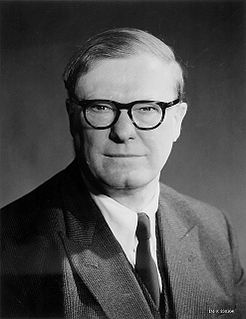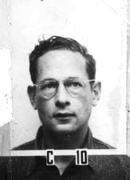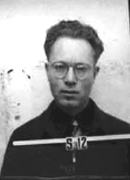 W
WHarold Melvin Agnew was an American physicist, best known for having flown as a scientific observer on the Hiroshima bombing mission and, later, as the third director of the Los Alamos National Laboratory.
 W
WLuis Walter Alvarez was an American experimental physicist, inventor, and professor who was awarded the Nobel Prize in Physics in 1968 for development of the hydrogen bubble chamber enabling discovery of resonance states in particle physics. The American Journal of Physics commented, "Luis Alvarez was one of the most brilliant and productive experimental physicists of the twentieth century."
 W
WFrederick Lincoln "Dick" Ashworth was a United States Navy officer who served as the weaponeer on the B-29 Bockscar that dropped a Fat Man atomic bomb on Nagasaki, Japan on 9 August 1945 during World War II.
 W
WFrancis Birch was an American geophysicist. He is considered one of the founders of solid Earth geophysics. He is also known for his part in the atomic bombing of Hiroshima and Nagasaki.
 W
WFrederick C. Bock was a World War II pilot who took part in the atomic bombing of Nagasaki in 1945.
 W
WTechnical Sergeant George Robert "Bob" Caron was the tail gunner, the only defender of the twelve crewmen, aboard the B-29 Enola Gay during the historic bombing of the Japanese city of Hiroshima on 6 August 1945. Facing the rear of the B-29, his vantage point made him the first man to witness the cataclysmic growth of the mushroom cloud over Hiroshima.
 W
WGeoffrey Leonard Cheshire, Baron Cheshire, was a highly decorated Royal Air Force (RAF) pilot and group captain during the Second World War, and a philanthropist.
 W
WMajor General Thomas Francis Farrell was the Deputy Commanding General and Chief of Field Operations of the Manhattan Project, acting as executive officer to Major General Leslie R. Groves, Jr.
 W
WThomas Wilson Ferebee was the bombardier aboard the B-29 Superfortress, Enola Gay, which dropped the atomic bomb, "Little Boy", on Hiroshima in 1945.
 W
WMorris Richard Jeppson was a Second Lieutenant in the United States Army Air Forces during World War II. He served as assistant weaponeer on the Enola Gay, which dropped the first atomic bomb on the city of Hiroshima, Japan on August 6, 1945.
 W
WWilliam Leonard Laurence was a Jewish American science journalist best known for his work at The New York Times. Born in the Russian Empire, he won two Pulitzer Prizes. As the official historian of the Manhattan Project, he was the only journalist to witness the Trinity test and the atomic bombing of Nagasaki. He is credited with coining the iconic term "Atomic Age," which became popular in the 1950s.
 W
WRobert Alvin Lewis was a United States Army Air Forces officer serving in the Pacific Theatre during World War II. He was the co-pilot and aircraft commander of the Enola Gay, the B-29 Superfortress bomber which dropped the atomic bomb Little Boy on the Japanese city of Hiroshima on 6 August 1945.
 W
WDonald Francis Mastick was a chemist who worked at the Manhattan Project's Los Alamos Laboratory. In August 1944, he swallowed some plutonium. As part of Project Alberta, he was part of the planning and preparation for the atomic bombing of Hiroshima and Nagasaki, for which he was awarded the Bronze Star Medal. He later worked for the Naval Radiological Defense Laboratory and the Atomic Energy Commission. In 1971, he founded his own interior landscape company, Foliage Plant Systems.
 W
WRear Admiral William Sterling "Deak" Parsons was an American naval officer who worked as an ordnance expert on the Manhattan Project during World War II. He is best known for being the weaponeer on the Enola Gay, the aircraft which dropped the Little Boy atomic bomb on Hiroshima, Japan in 1945. To avoid the possibility of a nuclear explosion if the aircraft crashed and burned on takeoff, he decided to arm the bomb in flight. While the aircraft was en route to Hiroshima, Parsons climbed into the cramped and dark bomb bay, and inserted the powder charge and detonator. He was awarded the Silver Star for his part in the mission.
 W
WWilliam George Penney, Baron Penney, was an English mathematician and professor of mathematical physics at the Imperial College London and later the rector of Imperial College. He had a leading role in the development of Britain's nuclear programme, a clandestine programme started in 1942 during World War II which produced the first British atomic bomb in 1952.
 W
WRear Admiral William Reynolds Purnell was an officer in the United States Navy who served in World War I and World War II. A 1908 graduate of the United States Naval Academy, he captained destroyers during World War I. He was awarded the Navy Cross for his role in protecting convoys against German submarines as commander of the USS Lamson.
 W
WNorman Foster Ramsey Jr. was an American physicist who was awarded the 1989 Nobel Prize in Physics, for the invention of the separated oscillatory field method, which had important applications in the construction of atomic clocks. A physics professor at Harvard University for most of his career, Ramsey also held several posts with such government and international agencies as NATO and the United States Atomic Energy Commission. Among his other accomplishments are helping to found the United States Department of Energy's Brookhaven National Laboratory and Fermilab.
 W
WRobert Serber was an American physicist who participated in the Manhattan Project. Serber's lectures explaining the basic principles and goals of the project were printed and supplied to all incoming scientific staff, and became known as The Los Alamos Primer. The New York Times called him “the intellectual midwife at the birth of the atomic bomb.”
 W
WCharles W. Sweeney was an officer in the United States Army Air Forces during World War II and the pilot who flew Bockscar carrying the Fat Man atomic bomb to the Japanese city of Nagasaki on August 9, 1945. Separating from active duty at the end of World War II, he later became an officer in the Massachusetts Air National Guard as the Army Air Forces transitioned to an independent United States Air Force, eventually rising to the rank of major general.
 W
WPaul Warfield Tibbets Jr. was a brigadier general in the United States Air Force. He is best known as the pilot who flew the B-29 Superfortress known as the Enola Gay when it dropped Little Boy, the first of two atomic bombs used in warfare, on the Japanese city of Hiroshima.
 W
WTheodore Jerome "Dutch" Van Kirk was a navigator in the United States Army Air Forces, best known as the navigator of the Enola Gay when it dropped the first atomic bomb on Hiroshima. Upon the death of fellow crewman Morris Jeppson on March 30, 2010, Van Kirk became the last surviving member of the Enola Gay crew.
 W
WBernard Waldman was an American physicist who flew on the Hiroshima atomic bombing mission as a cameraman during World War II.